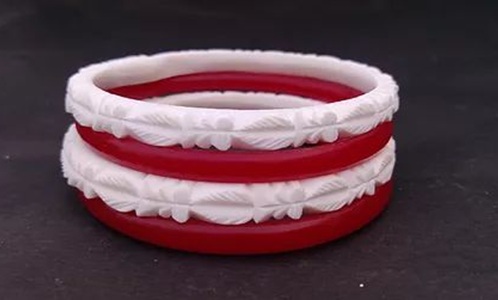In Bengali culture, Shakha Pola are traditional bangles made from conch shell (shakha) and red coral (pola), worn by married women as a symbol of marital status, prosperity, and cultural identity. These bangles are more than mere ornaments—they hold spiritual and cultural significance, particularly in rituals and festivals like Saptapadi and Sandhi Puja. With their rising popularity, however, many imitation Shakha Pola are sold in the market. Identifying original shakha pola is essential to ensure authenticity, durability, and traditional value.

Understand the Material
- Shakha (White Bangles): Made from natural conch shell, genuine shakha has a smooth, slightly glossy surface and feels firm yet lightweight.
- Pola (Red Bangles): Traditionally made from red coral, but modern ones can also be made from lac or synthetic materials.
- Authentic shakha and pola are organic and natural, whereas fake versions often use plastic, resin, or dyed materials that are brittle or overly glossy.
Color and Texture
- Original Shakha: Pure white, creamy, or off-white. The surface is slightly uneven and naturally textured, reflecting its organic origin.
- Fake Shakha: Pure bright white or perfectly uniform, often indicating artificial bleaching or plastic.
- Original Pola: Bright red, with a natural, warm hue. Genuine coral may have slight variations in color, which adds authenticity.
- Fake Pola: Bright red plastic or painted bangles that look too uniform and artificial.
Weight Test
- Real shakha is lightweight but firm, while red coral is slightly heavier due to its density.
- Fake materials may feel heavier (if made of resin) or too light (if plastic), giving away their artificial nature.
- Hold the bangles together; organic shakha and pola should feel balanced and comfortable on the wrist.
Sound Test
- Gently tap two shakha bangles together; original conch shell produces a soft, natural ringing sound.
- Fake bangles, especially plastic or resin, produce a dull, hollow, or harsh sound.
- Similarly, tapping the red coral (pola) should yield a solid but mild sound, indicating dense organic material.
Check for Imperfections
- Original shakha has minor natural imperfections or streaks, which are signs of authenticity.
- Pola may also have tiny irregularities in color or surface texture.
- Fake bangles often appear too smooth, glossy, and uniform, which is a clear indicator of artificial production.
Durability Test
- Genuine shakha and pola are resistant to chipping and cracking under normal wear.
- However, fake plastic or resin bangles are more brittle and prone to breaking when gently pressed or dropped.
Smell Test
- Original shakha and coral are odorless or have a very mild earthy smell.
- Fake bangles made of synthetic materials may have a chemical or plastic-like odor, especially when new.
Cultural Markers and Craftsmanship
- Authentic shakha pola often come from reputed Bengali artisans and may include traditional designs or engraved patterns.
- Fake bangles lack the cultural craftsmanship, looking mass-produced with generic shapes or designs.
Quick Comparison Table: Original vs Fake Shakha Pola
| Feature | Original Shakha Pola | Fake Shakha Pola |
| Material | Natural conch and red coral | Plastic, resin, or synthetic |
| Color | Creamy white (shakha), natural red (pola) | Uniform bright white/red |
| Texture | Slight natural unevenness | Too smooth and glossy |
| Weight | Balanced, firm | Too heavy or too light |
| Sound | Soft, natural ringing | Dull or harsh |
| Imperfections | Minor natural streaks or variations | Perfectly uniform |
| Durability | Strong, resistant | Brittle, breaks easily |
Final Thoughts
Identifying original shakha pola requires careful attention to material, color, texture, weight, sound, and natural imperfections. Genuine bangles carry not only aesthetic and cultural value but also spiritual significance for married women in Bengal. Purchasing from trusted artisans or verified stores ensures you bring home authentic shakha pola that honor tradition, durability, and elegance.